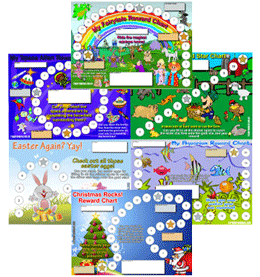Using a reward chart is a wonderful way to help your child see and experience the true benefits of great behavior.
Used with consistency and following the general rules and principles of a positive reinforcement strategy, your child will learn to be motivated not by the extrinsic rewards on offer (which we must acknowledge as a powerful motivator), to a more intrinsic reward – those rewards not on offer, the rewards that come from within – the reward a child feels when they have achieved a goal, or behaved well, or when they have given up an ingrained contrary behavior. These are the rewards your child may not expect to receive. With this understanding, children begin the process of being motivated by their own desire to feel good.
Consider, that sometimes for your child to discover the unexpected and automatic rewards inherent in using positive behaviors, you have to create a happy result that your child can readily anticipate, envision, and choose to work toward. Once there, these unexpected rewards become an additional pleasant consequence, and over time these unexpected rewards can become the motivation for good behavior in and of themselves.
Upon further examination, these unexpected or inherent rewards become even more evident. Your child will naturally grow as a result of their successes, and the relationship between you and your child will involve more positive interactions. It’s win-win all around, for example:
- Your child’s self-esteem will be enhanced. When attention is paid to children’s good behaviors rather than concentrating on the bad ones, children feel better about themselves. They see themselves as appreciated. They experience a sense of accomplishment as they work toward and achieve their goals. At every point of recognition their self-image will grow.
- Children have a natural, innate desire to become independent. When using a reward chart children can exercise that need for independence, they can choose to behave in a way that will bring them closer to, and achieve their reward. The distinction is that they are responding to their own desire to reach their reward, not to your demands that they behave the way you want them too. With a behavior chart in use, it is not your desires that are paramount, but rather your child’s and they will feel it that way. Now unburdened with “do this” and “do that”, they are left to make choices of their own.
- The interplay between you and your child become more enjoyable. When children are trapped in patterns of poor behaviours, or the “negative cycle”, they often drag their parents into that same “negative cycle”. Parents can respond badly in this situation – when a child is rude or behaves poorly, often parents can snap back, criticize, threaten, or generally withdraw their affection, and your child will further respond to this, or withdraw into themselves. This pattern repeats itself, and the cycle continues on and on. Adopting the principles of positive reinforcement coupled with a reward based strategy can put a stop to this.
- You allow your child to experience the satisfaction and pleasure of working toward a goal, while there is an underlying lesson of delayed gratification taking place.

